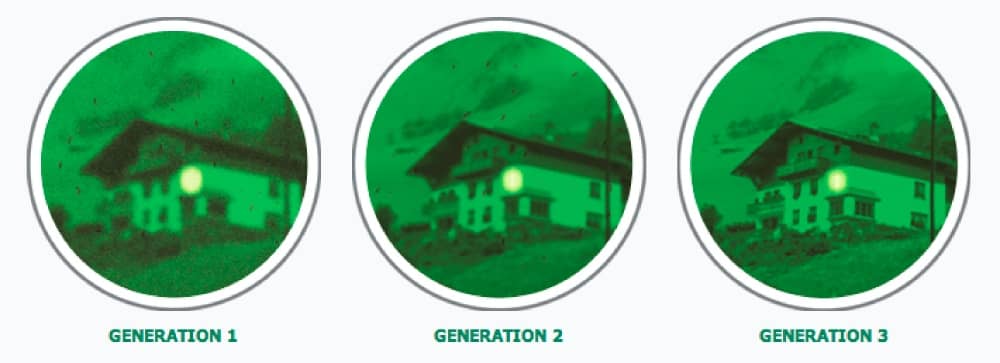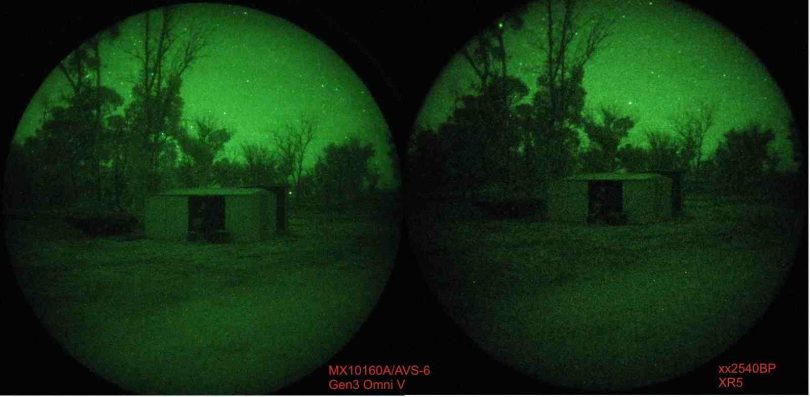Since its invention, night vision has come a long way. Currently, it comes with 3 separate night vision generations.
The generation is defined by the specific image intensifier tube made for night vision devices. Image intensifier tubes are a vacuum-sealed tube that contains a photocathode, and microchannel plate, with a phosphor screen that enables it at night.
People mostly use either gen 2 or gen 3-night vision goggles nowadays. There is a lot of confusion about which gen is the best, so we’re here to finish the debate once and for all.
Let’s dive deep and explore what separates each generation of night vision goggles from the others.
Night vision technology was conceived in the early 1960s, with the invention of the Gen 1-night vision. Gen 1 is still pretty common because of its affordability.
However, we can question the range, resolution, and versatility of the Gen 1 when compared with other later generations.
Today, we’re exploring the Gen 2 vs Gen 3 Night Vision debate to help you find the best one for you.
Gen 1 also relies heavily on built-in illuminators just like top-notch flashlights.
But this time they are invisible to the naked eye, which also makes the user seen by others with night vision technology.
Night Vision Generations: A Brief History

What Makes a Generation?
The generations of night vision are measured by the quality of the night vision output.
The part which is most known for the quality output is the photo-multiplier tube—they are also known as the Image Intensification Tube (IIT)
Subsequently, when the device catches the little available light, they arrive through the objective lens and hits the photocathode.
The photocathode changes the light further into photons to electrons. This photocathode part changes light into a piece of usable electronic information for the night vision device.
However, these electronic signals need amplification and acceleration for them to be valuable. The photomultiplier does this.
The tube amplifies, speeds up, and changes the electronic signals into an image that is clear enough to be visible through the ocular lens. The advances in multipliers define each generation.
Hence, the later generation produces better and clearer images than the variant prior, and also defines the price of each.
Gen 2 Night Vision Explained
Gen 1 is a popular option in civil operations.
However, the major difference between Gen 1 and Gen 2 is the introduction of the microchannel plate to the apparatus.
The microchannel plate is the component of the IIT system that has a multitude of individual photons-detectors and amplification passages.
Instead of having a few channels which work at once, you can have efficient night vision.
Also, depending on the model, they create visuals of more than 200 yards, and when they are compared to generation 1, they show better cleaner, and brighter images. Importantly, you can use them without IR illumination.
As they create a bright image, there is no part of the image that is distorted, especially in the outer area that in earlier generations would produce distorted images.
If the battery is your concern, the battery life of the Gen 2 goes way longer than the gen two and is not prone to “blooming” the way they are in others.
If you can afford to get a gen two-night vision, then it is worth it. Even though they are pricier than Gen 1, Gen 2 shows more promise for effective night vision.
Gen 3 Night Vision Explained
The Gen 3 distances itself in terms of quality, from the rest. Just like Gen 2, Gen 3 comes with a similar microchannel plate.
However, the microchannel comes with an upgrade. Gen 3 night vision photocathodes, hold a layer of gallium arsenide.
The crystalline chemical layer of the structure does a better job of semiconducting the basic photocathodes.
Hence, Gen 3’s upgraded photocathodes are even better and can transfer a higher-quality electronic signal.
The extra ion barrier on the Gen 3’s microchannel plate shows something spectacular.
They do not just extend the lifespan of the night vision, but they limit the amount of electric signal obstruction that might mitigate the efficient usage of your night vision.
Night Vision Gen 2 vs Gen 3: Key Difference
Let’s now figure out who is the ultimate winner of the “gen 2 night vision vs gen 3 night vision” comparison.
Night vision technology has come a long way in the last few decades, and there are now two major generations of night vision equipment.
Gen 2 and Gen 3 represent cutting-edge night vision technology, and they offer different levels of performance and capabilities.
The main differences between the two generations lie in their resolution, sensitivity to light, signal-to-noise ratio, and overall image quality.
Gen 2 night vision equipment is the older generation of technology, and it produces images that are much blurrier than those produced by Gen 3 technology. These devices also have limited resolution, meaning that they can’t resolve objects as clearly as their Gen 3 counterparts.
As a result, the winner of our “gen 2 vs gen 3 night vision” comparison is gen 3.
Night Vision Gen 1 vs 2 vs 3: Detailed Comparison

The best night vision on the market is the Gen 3 night vision device. They have a better resolution than the Gen 2 and show a cleaner and brighter image.
The Gen 3, not only wops the Gen 2 in the quality of the images it produces, but also in the range of sight, of more than 300 yards while the Gen 2 boasts, a meager 200 yards. The life expectancy of Gen 3 and Gen 2 also is no match.
While a generation 3 owner, expects their device to last more than 10, 000 hours, the Gen 2 owner can only hold on for only about five thousand hours.
Furthermore, the Gen 3 night vision devices cost more than the Gen 2, but considering the superior quality of the Gen 2 night vision, they are justifiable.
The gen three-night vision device is military-grade equipment and not for the casual user. If you intend to get one for yourself, the Gen 2 is what you need. But, if you do not mind the cost, and are looking for the ultimate experience, Gen 3 provides that.
The main difference between Gen 1, 2, and 3-night vision technology is the resolution.
In general, Gen 1 NVGs have a resolution of around 20-30 lp/mm, Gen 2 offers up to 64-72 lp/mm, and Gen 3 can reach resolutions as high as 64-72 lp/mm for the highest quality models.
The resolution determines the amount of detail you can see in the image, which is why higher resolutions are more desirable for night vision devices.
Additionally, Gen 2 and 3 NVGs tend to have a better signal-to-noise ratio when compared to their Gen 1 counterparts, allowing for clearer images in dark environments.
Conclusion
When it comes to night vision technology, the difference between Gen 2 and Gen 3 is significant. In this “gen 2 vs gen 3 night vision” comparison guide, we’ve tried to provide a simplified overview of the night vision generations.
Gen 2 offers a higher resolution than its predecessor and allows for better detection of targets at greater distances in low-light conditions.
On the other hand, Gen 3 provides enhanced image clarity and contrast with improved performance in total darkness due to its advanced intensifier tube design.
Both generations have their own set of advantages that make them suitable for different uses depending on your needs.
Ultimately, whether you choose Night Vision Generation 2 or Generation 3 will depend on what application you need it for as both offer unique benefits that can suit any situation.
With this, we’ve reached the end of our today’s discussion. Hopefully, you’ve found all the info you were searching for. Please let us know if you have any thoughts or opinions to share. Thanks for reading this far.
FAQs:
Q. 1: Who Invented Night Vision?
Ans: After the Second World War, the earliest commercial night vision was invented by Vladimir K. Zworykin.
Q. 2: How Many Generations of Night Vision Are There
Ans: Night vision devices can either be 1st generation, 2nd generation, 3rd generation or 4th generation depending on
Q. 3: Does Night Vision Work in Total Darkness?
Ans: The digital intensifiers of night vision tubes are passive devices. They require the natural light from the sun, moon, and stars for an image, hence they will not work effectively on cloudy nights and in total darkness.
Q. 4: Can Civilians Own NVGs?
Ans: Yes, you can own NVG gear like night vision binoculars or monoculars. However, depending on where you are, they are illegal to attach them to a gun or weapon.
Q. 5: What’s the Latest Generation of Night Vision?
Ans: The latest generation of night vision is the generation 3 device. However, there are others marketed as generation 4. But they do not hold a substantial upgrade to be considered generation 4
Q. 6: What Is the Difference Between Generations of Night Vision?
Generations of night vision can be divided into 3 categories: Generations 1, 2, and 3.
Gen 1 night vision devices rely on an image intensifier to amplify existing light in order to provide a low-resolution image whereas Gen 2 night vision devices are the next step up and incorporate a microchannel plate that provides significantly improved resolution, better clarity, and a wider field of view.
On the other hand, Gen 3 night vision devices are the most advanced type available, using gallium arsenide photocathodes to provide excellent performance in low-light conditions. They offer superior image quality and a greater range of view.









Leave a Comment